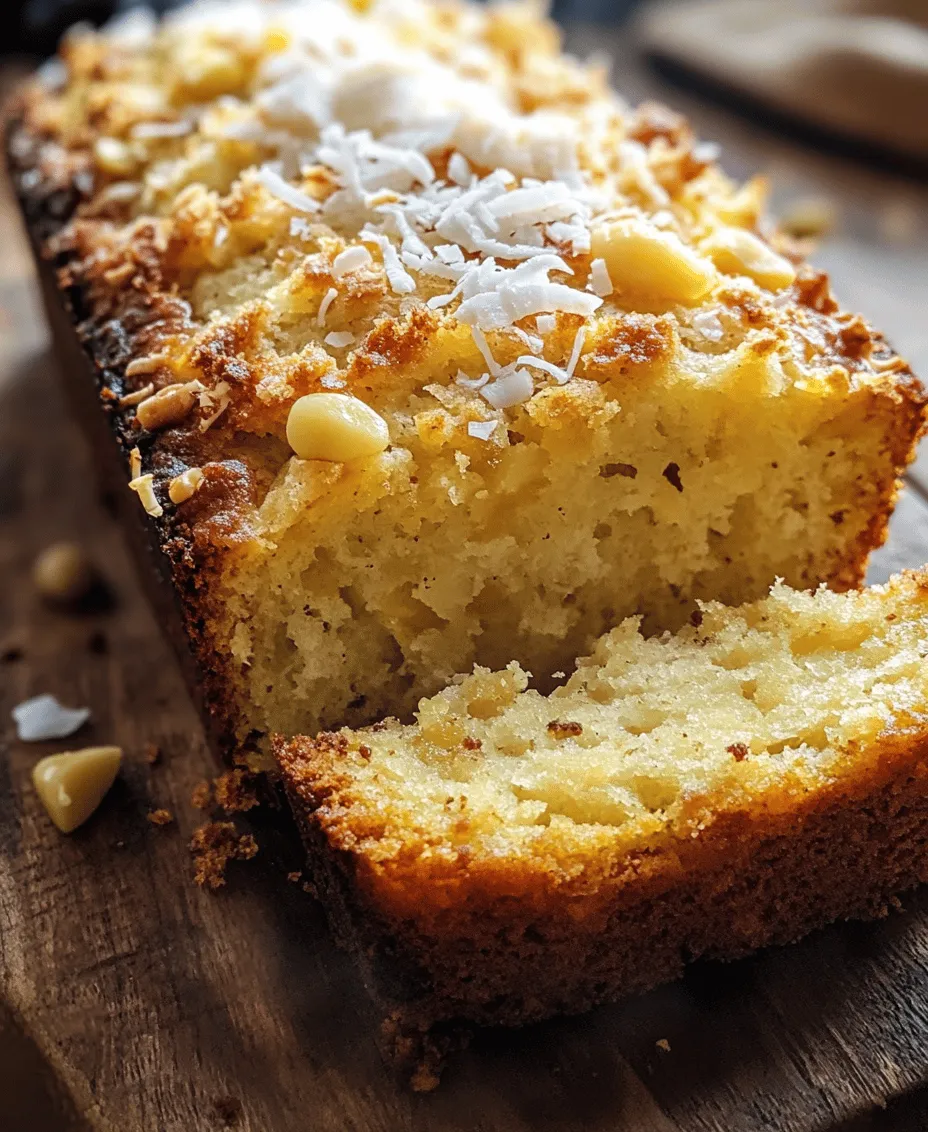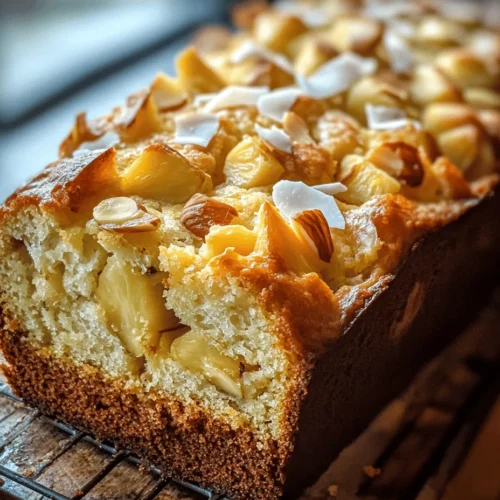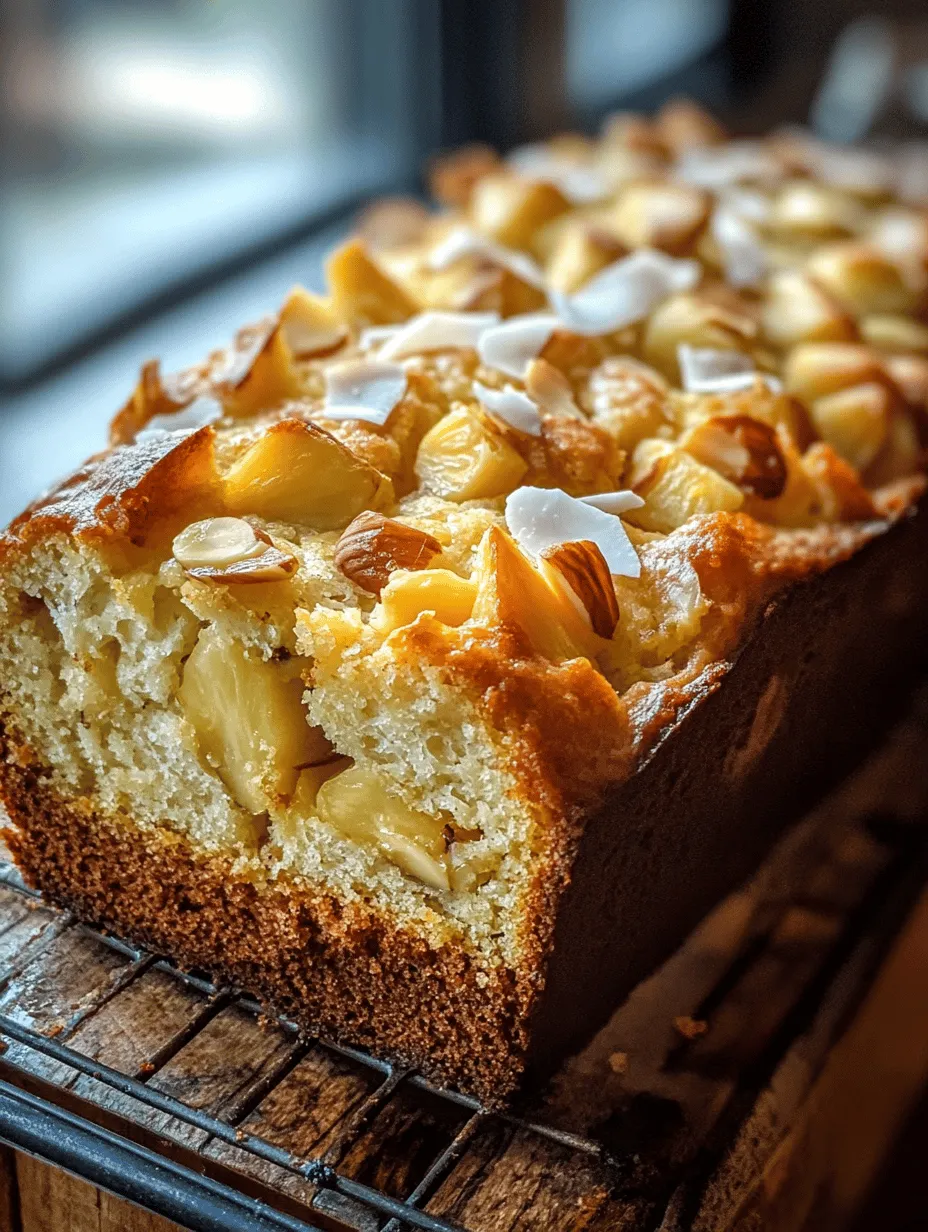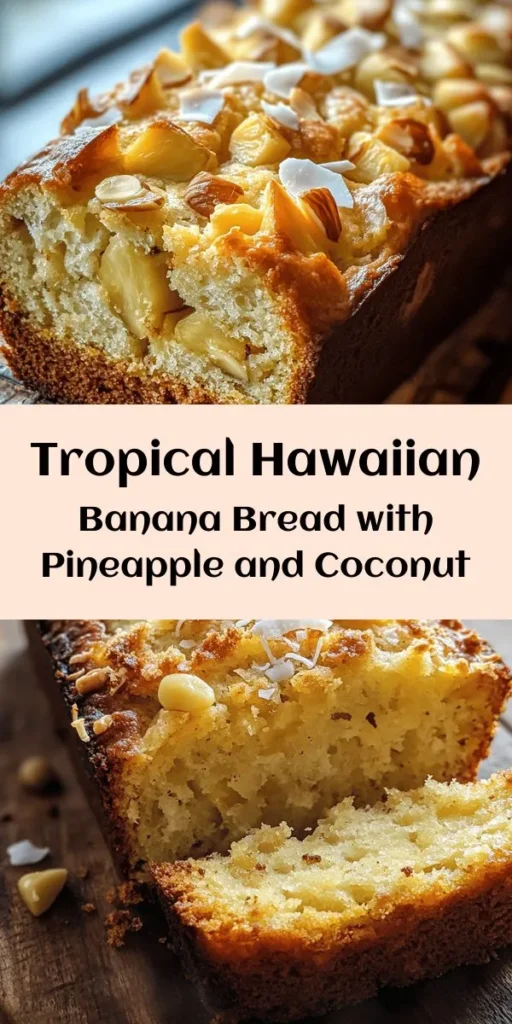Introduction
Delve into a slice of paradise with our Hawaiian Banana Bread, a delightful fusion of tropical flavors that captures the essence of the islands. This recipe offers a perfect blend of ripe bananas, sweet pineapple, and shredded coconut, making it a scrumptious treat for breakfast, snacks, or dessert. The addition of macadamia nuts or walnuts provides a satisfying crunch, while the warm spices elevate its taste. Whether you’re a banana bread aficionado or a curious culinary explorer, this recipe promises to transport your taste buds to a tropical haven.
Banana bread has long been a beloved staple in many households, known for its comforting aroma and moist texture. The Hawaiian twist on this classic recipe introduces a vibrant medley of tropical ingredients that not only enhance the flavor but also the overall experience. Imagine slicing into a warm loaf, where the sweet scent of ripe bananas mingles with the tropical notes of pineapple and coconut. Each bite is a reminder of sunny beaches, swaying palm trees, and the laid-back lifestyle of Hawaii.
This Hawaiian Banana Bread is not just a treat for the taste buds; it’s also a canvas for creativity. You can experiment with different mix-ins and spices, making it a versatile recipe that can be tailored to your preferences. Whether you prefer a nutty crunch or a spiced kick, this recipe provides a solid foundation to build upon. So, gather your ingredients and embark on a culinary journey that will leave you dreaming of the tropics.
Understanding the Ingredients
Highlighting the Core Components
To create the perfect Hawaiian Banana Bread, it’s essential to understand the role of each ingredient. From the key components that contribute to its unique flavor to the science behind the baking process, knowing your ingredients will elevate your baking game.
Exploring Ripe Bananas and Their Benefits
Ripe bananas are the star of this recipe, providing both natural sweetness and moisture. When bananas are fully ripe, they develop a rich flavor profile and are easier to mash, which helps blend seamlessly into the batter. Additionally, ripe bananas are packed with potassium, vitamin C, and dietary fiber, making this bread a healthier indulgence. The natural sugars in bananas also reduce the need for added sweeteners, allowing the other ingredients to shine.
The Role of Crushed Pineapple in Moisture and Flavor
Crushed pineapple is another essential ingredient in Hawaiian Banana Bread. Not only does it add a tropical flair, but it also contributes to the bread’s moisture and sweetness. The natural acidity in pineapple helps to enhance the flavor of the bananas, creating a harmonious blend. When selecting pineapple for this recipe, opt for canned crushed pineapple in its own juice to ensure the best flavor and texture. Draining excess liquid before mixing will help achieve the perfect batter consistency.
The Sweetness of Shredded Coconut
Shredded coconut introduces a delightful chewiness and tropical flavor that complements the other ingredients. When toasted, shredded coconut adds depth to the bread’s flavor profile, enhancing the overall experience. In addition to its delicious taste, coconut is a source of healthy fats, making it a nutritious addition. Look for unsweetened shredded coconut to control the overall sweetness of your bread.
Butter: The Secret to a Rich Texture
Butter is a crucial ingredient that contributes to the rich, tender texture of the banana bread. The fat in butter coats the flour, allowing for a moist crumb and a slightly crisp crust. Using unsalted butter gives you control over the saltiness of the final product, ensuring a balanced flavor profile. For an even richer taste, consider browning the butter before adding it to the batter, which will impart a nutty aroma and enhance the overall flavor.
Sugar – Balancing Sweetness with Natural Flavors
While ripe bananas and crushed pineapple provide natural sweetness, sugar plays a role in balancing the flavors and enhancing the bread’s structure. Granulated sugar is commonly used in this recipe, but you can also experiment with brown sugar for a deeper flavor. Brown sugar contains molasses, which adds moisture and a hint of caramel notes, making your Hawaiian Banana Bread even more indulgent.
Eggs: Binding and Moisture in Baking
Eggs serve multiple purposes in baking, providing moisture, richness, and structure to the banana bread. They act as a binding agent, helping to hold all the ingredients together while contributing to the overall texture. The proteins in eggs also help create a stable structure, ensuring your bread rises beautifully. For a vegan alternative, you can substitute eggs with unsweetened applesauce or flaxseed meal mixed with water.
The Importance of Vanilla Extract
Vanilla extract is the secret ingredient that elevates the flavor of your Hawaiian Banana Bread. It adds depth and complexity, complementing the sweetness of the bananas and pineapple. Always opt for pure vanilla extract for the best results, as imitation vanilla can lack the rich flavor that truly enhances your baked goods.
Baking Soda as a Leavening Agent
Baking soda is the leavening agent in this recipe, helping the bread rise and achieve a light, airy texture. It reacts with the acids in the bananas and pineapple, producing carbon dioxide bubbles that give the bread its lift. Make sure your baking soda is fresh to ensure optimal rising. If you’re unsure, test it by adding a small amount to vinegar; it should fizz vigorously if it’s still active.
Salt: Enhancing the Overall Flavor
Salt is a crucial component in any baked good, including banana bread. It enhances the overall flavor, balancing the sweetness and bringing out the natural tastes of the other ingredients. A small amount goes a long way, so don’t skip this step! The combination of salt and sugar creates a more complex flavor that elevates your Hawaiian Banana Bread to new heights.
All-Purpose Flour: The Foundation of the Bread
All-purpose flour is the backbone of your banana bread, providing structure and stability. It absorbs moisture from the other ingredients and helps create the desired texture. When measuring flour, it’s essential to avoid packing it into the measuring cup, as this can result in a dense loaf. Instead, spoon the flour into the cup and level it off for the perfect amount.
Optional Ingredients: Nuts and Spices for Added Flavor
While the core ingredients create a delicious banana bread, optional additions can take your creation to the next level. Chopped nuts, such as macadamia nuts or walnuts, add a delightful crunch and nutty flavor that pairs beautifully with the tropical ingredients. Spices like cinnamon or nutmeg contribute warmth and depth, enhancing the overall flavor profile. Feel free to experiment with these additions to make the recipe your own!
Preparation Steps Explained
Creating the ultimate Hawaiian Banana Bread is a straightforward process that begins with proper preparation. Follow these steps carefully to ensure a delicious outcome.
Prepping Your Kitchen and Ingredients
Before you start baking, take a moment to gather all your ingredients and tools. This includes ripe bananas, crushed pineapple, shredded coconut, eggs, butter, sugar, flour, baking soda, vanilla extract, and salt. Having everything within reach will streamline your baking process and keep you organized.
Setting the Stage: Preheating the Oven
Preheat your oven to 350°F (175°C). This step is crucial, as a properly preheated oven ensures even baking and helps your banana bread rise beautifully. While the oven is heating, you can prepare your ingredients and pans, maximizing efficiency in the kitchen.
Choosing the Right Pan: Greasing vs. Parchment Lining
Selecting the right baking pan is essential for successful banana bread. A 9×5-inch loaf pan is ideal for this recipe. You can either grease the pan generously with butter or cooking spray or line it with parchment paper for easy removal. If using parchment paper, allow some overhang on the sides, which will make it easier to lift the bread out once it’s baked.
Mixing the Wet Ingredients: Creaming Butter and Sugar
In a large mixing bowl, start by creaming together the softened butter and sugar until the mixture is light and fluffy. This step incorporates air into the butter, contributing to a lighter texture in your banana bread. Use an electric mixer or a whisk for this process, ensuring the sugar is fully dissolved into the butter.
Incorporating Bananas and Pineapple: Achieving the Ideal Consistency
Next, it’s time to add the ripe bananas and crushed pineapple to the creamed mixture. Mash the bananas in a separate bowl before adding them to achieve a smoother consistency. Gently fold the mashed bananas and drained pineapple into the mixture until well incorporated. Be careful not to overmix; the goal is to combine the ingredients without losing the air you’ve whipped into the butter and sugar.
Combining Dry Ingredients: Importance of Not Overmixing
In a separate bowl, whisk together the all-purpose flour, baking soda, and salt. This step ensures that the baking soda is evenly distributed throughout the flour, which is essential for consistent rising. Gradually add the dry mixture to the wet ingredients, stirring gently until just combined. Overmixing can lead to a dense loaf, so be sure to stop mixing as soon as you no longer see dry flour.
Folding in Coconut and Nuts: Ensuring Even Distribution
Once the batter is well combined, it’s time to fold in the shredded coconut and any nuts you’re using. Gently incorporate these ingredients to ensure they are evenly distributed throughout the batter. This step adds texture and enhances the tropical flavors of the bread, creating a delicious and satisfying loaf.
Pouring and Smoothing the Batter: Preparing for Baking
Finally, pour the batter into your prepared loaf pan, using a spatula to smooth the top evenly. This will help ensure that the bread bakes evenly and rises nicely in the center. Once the batter is in the pan, you can tap it lightly on the counter to release any air bubbles trapped inside, further contributing to a fluffy texture.
With your batter ready, you’re just moments away from baking a slice of tropical bliss. The aroma of freshly baked Hawaiian Banana Bread will soon fill your kitchen, enticing everyone around you to come and enjoy a taste of the islands. Stay tuned for the next steps, where we’ll guide you through the baking process and how to achieve the perfect loaf!

Baking Process: Understanding Time and Temperature
Baking Hawaiian banana bread requires not only the right ingredients but also a precise understanding of time and temperature. Preheating your oven to 350°F (175°C) is crucial as it ensures that the bread bakes evenly. When the oven reaches this temperature, the baking soda activates, helping the bread rise beautifully.
Baking Times: The typical baking time for this recipe is between 50 to 60 minutes. However, every oven is unique, and factors like altitude and humidity can affect baking times. It’s essential to check the bread around the 50-minute mark.
Temperature Tips: If your bread is browning too quickly on top, you can tent it with aluminum foil. This simple trick prevents the crust from burning while allowing the inside to continue cooking through.
Cooling Down: Why It Matters Before Slicing
Once your Hawaiian banana bread is out of the oven, it’s tempting to slice into it right away. However, patience is key. Allow the bread to cool in the pan for about 10 to 15 minutes before transferring it to a wire rack. Cooling helps the structure of the bread to set, ensuring that it slices neatly without crumbling.
If you skip this step and cut into the bread while it’s still warm, you might end up with a gooey mess rather than a beautifully sliced loaf. Once completely cooled, the flavors meld together, enhancing the tropical taste of coconut and pineapple, making each slice a delightful experience.
Baking Tips for Perfect Hawaiian Banana Bread
Here are some expert tips to ensure your Hawaiian banana bread turns out perfectly every time:
1. Use Overripe Bananas: The key to moist banana bread is using overripe bananas. They should be heavily speckled or even black. Their natural sugars enhance sweetness and moisture.
2. Incorporate Ingredients Gradually: When mixing your dry ingredients with the wet ones, do so gently. Over-mixing can lead to dense bread.
3. Experiment With Mix-Ins: While the recipe highlights pineapple and coconut, feel free to add macadamia nuts or shredded carrots for added texture and flavor.
4. Check for Doneness: Insert a toothpick in the center of the bread. If it comes out clean or with a few moist crumbs, your bread is ready.
Understanding the Science of Baking
Baking is as much a science as it is an art. Understanding the reaction between ingredients helps in achieving the best results.
– Baking Soda Activation: The baking soda reacts with the acidity of the pineapple, creating carbon dioxide bubbles that help the bread rise.
– Moisture Retention: Both bananas and pineapple contribute significant moisture, allowing for a tender crumb.
– Flavor Development: As the bread bakes, the sugars caramelize, enhancing the flavors of coconut and banana, creating that signature tropical taste.
Common Mistakes to Avoid
1. Not Preheating the Oven: Skipping this step can result in uneven cooking.
2. Using Cold Ingredients: Room temperature eggs and melted butter mix better, leading to a smoother batter.
3. Not Measuring Ingredients Accurately: Use a kitchen scale or proper measuring cups to ensure accurate ingredient proportions.
How to Tell When Your Banana Bread is Done
To ensure your Hawaiian banana bread is perfectly baked, rely on these indicators:
– Color: The bread should be a golden brown on top.
– Spring Test: Gently press the top; it should spring back.
– Toothpick Test: As mentioned earlier, inserting a toothpick into the center should yield clean or slightly moist results.
Storing Leftovers: Keeping It Fresh
If you have leftover Hawaiian banana bread, proper storage is essential to maintain its moisture and flavor.
– Room Temperature: Wrap the bread in plastic wrap or foil and store it in an airtight container for up to three days.
– Refrigeration: For longer storage, consider refrigerating it, but this may lead to a drier texture. If you choose this route, ensure it’s well-wrapped.
Ways to Reheat for Optimal Taste
When you’re ready to enjoy your banana bread again, reheating it can bring back its delightful freshness. Here are a couple of methods:
– Oven Method: Preheat your oven to 350°F (175°C) and wrap the bread in foil. Heat for about 10-15 minutes, or until warmed through.
– Microwave Method: For a quick fix, place a slice in the microwave for 10-15 seconds. Be careful not to overheat, as it can dry out.
The Cultural Significance of Banana Bread in Hawaiian Cuisine
Hawaiian banana bread is more than just a delicious baked good; it holds a special place in Hawaiian culture and cuisine.
Historical Background of Banana Bread in Hawaii
Banana bread’s origins in Hawaii can be traced back to the introduction of bananas by Polynesian settlers. This fruit became a staple, leading to the creation of various recipes, including the beloved banana bread. With the influence of other cultures, such as American and Asian, the bread evolved into a unique Hawaiian delicacy.
Tropical Fruits and Their Role in Hawaiian Cooking
Hawaii’s tropical climate allows for a variety of fruits to thrive. Pineapples, coconuts, and bananas are among the most popular, frequently incorporated into local dishes. The combination of these fruits in banana bread not only enhances flavor but also celebrates the rich agricultural heritage of the islands.
The Influence of Local Ingredients on Traditional Recipes
Local ingredients, such as macadamia nuts and fresh coconut, add depth and authenticity to Hawaiian banana bread. These elements reflect the islands’ unique ecosystems and agricultural practices, making each loaf a representation of Hawaii’s natural bounty.
How Hawaiian Banana Bread Stands Out Among Other Variants
Unlike traditional banana bread, Hawaiian banana bread features the addition of pineapple and coconut, giving it a distinct tropical flavor profile. This fusion not only sets it apart from other variations but also showcases the islands’ culinary diversity.
Serving Suggestions and Pairings
To truly enjoy your Hawaiian banana bread, consider these creative serving suggestions:
Creative Ways to Serve Hawaiian Banana Bread
– Toast it: Lightly toast slices in a pan or toaster for a delightful crunch and serve with butter or cream cheese.
– French Toast Style: Dip slices in egg batter and cook for a decadent breakfast treat.
– Dessert Toasts: Top slices with whipped cream, fresh fruit, or a drizzle of honey for a delightful dessert.
Pairings with Tropical Fruits
Enhance your experience by serving banana bread with tropical fruits such as:
– Fresh Pineapple: The acidity complements the sweetness of the bread.
– Mango Slices: Their tropical sweetness pairs beautifully.
– Coconut Chunks: Fresh coconut adds a delightful texture.
Beverage Options: Coffee, Tea, or Smoothies?
Consider pairing your Hawaiian banana bread with:
– Coffee: A rich, dark roast accentuates the sweetness of the bread.
– Herbal Tea: Chamomile or hibiscus tea can provide a refreshing contrast.
– Smoothies: Blend up a tropical smoothie with mango, banana, and coconut milk for a complementary drink.
Making it a Complete Meal: Breakfast Ideas
Transform your Hawaiian banana bread into a complete meal by serving it as part of a breakfast spread. Pair slices with Greek yogurt, fresh fruit, and a serving of nuts for added protein and richness.
Nutritional Information
Understanding the nutritional content of Hawaiian banana bread can help you enjoy it responsibly:
Breaking Down the Health Aspects of Each Ingredient
– Bananas: Packed with potassium and vitamins C and B6, bananas provide energy and support heart health.
– Pineapple: Rich in vitamin C and bromelain, pineapple aids digestion and boosts immunity.
– Coconut: High in healthy fats, coconut can provide energy and assist with metabolic health.
The Nutritional Benefits of Bananas, Pineapple, and Coconut
Each ingredient contributes to the overall nutritional profile of the bread, making it a wholesome treat. The fiber from bananas and pineapple helps with digestion, while the healthy fats from coconut promote satiety.
Balancing Indulgence and Nutrition
While Hawaiian banana bread is undeniably delicious, moderation is key. Enjoying a slice as part of a balanced diet ensures you can savor this treat without guilt.
Understanding Portion Sizes: How to Enjoy Responsibly
A typical serving size of banana bread is one slice. Being mindful of portion sizes allows you to relish the flavors without overindulging.
Conclusion
Incorporating a tropical twist into your baking repertoire, this Hawaiian banana bread with pineapple and coconut is more than just a delicious treat; it’s a culinary journey to the vibrant islands of Hawaii. With its harmonious blend of flavors and textures, this recipe is sure to become a favorite among family and friends. Embrace the joy of baking and savor each bite of this delightful creation, making it a staple in your kitchen for years to come. Whether enjoyed for breakfast, as a snack, or as a dessert, this banana bread will transport you to the beautiful shores of Hawaii with every mouthful.



